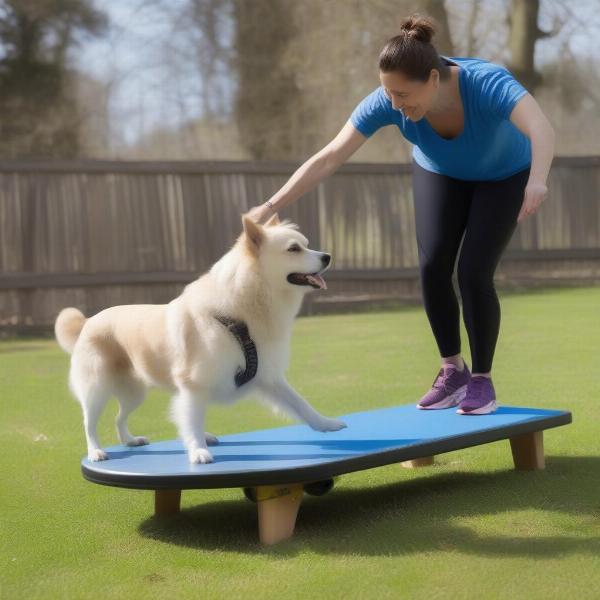Three legged dog yoga might seem unusual, but with thoughtful modifications, it can be a rewarding experience for both you and your tripawd. This practice can offer gentle stretches, improve balance, and strengthen remaining limbs. It also provides a unique bonding opportunity, fostering a deeper connection with your resilient canine companion. We’ll explore the benefits, modifications, and precautions necessary to make yoga a positive and enriching experience for your three-legged friend.
Benefits of Yoga for Three Legged Dogs
Yoga for three legged dogs can improve their physical and mental wellbeing. Gentle stretches can alleviate stiffness, particularly in the remaining three limbs which often bear extra weight. Balance exercises, crucial for tripawds, can be significantly enhanced through yoga. Furthermore, the focused attention and calm environment fostered during a yoga session can reduce anxiety and stress, improving your dog’s overall mental state.
Modifying Yoga Poses for Tripawds
Adapting yoga poses is key to a safe and beneficial practice. Standard poses need to be adjusted to accommodate the missing limb, ensuring your dog isn’t overexerting or straining their body. For instance, the downward-facing dog can be modified by gently lifting the remaining rear leg, focusing on the stretch in the front legs and spine. Consult with a veterinarian or canine rehabilitation specialist for personalized pose modifications tailored to your dog’s specific needs and physical condition. They can help create a routine that maximizes benefits while minimizing the risk of injury.
Building Strength and Balance in Your Three Legged Dog
Yoga can help build strength in the remaining limbs, crucial for a three legged dog’s mobility and overall health. Poses like the “seated pose” (modified to account for balance) can strengthen core muscles and improve posture. Balance, naturally a challenge for tripawds, can be greatly improved through specific yoga poses. Gentle rocking movements and supported stands can help your dog develop better body awareness and improve their stability.
 Three Legged Dog Balance Exercises
Three Legged Dog Balance Exercises
Precautions and Considerations for Three Legged Dog Yoga
Always prioritize your dog’s comfort and safety. Start slowly with short sessions and gradually increase the duration as your dog becomes more comfortable. Observe your dog’s body language throughout the session, looking for signs of discomfort or pain. Never force your dog into a pose, and stop immediately if they show any signs of distress. Consulting with a veterinarian before starting yoga is especially crucial for dogs with pre-existing conditions like arthritis or hip dysplasia.
Creating a Relaxing Yoga Environment
A calm and quiet environment is essential for a successful yoga session. Choose a comfortable, non-slip surface like a dog yoga mat and minimize distractions. Gentle music and soft lighting can further enhance relaxation. Remember, the goal is to create a positive and enjoyable experience for both you and your dog. Consider using treats and positive reinforcement to encourage participation and make the experience even more rewarding.
Conclusion
Three legged dog yoga, with careful modification and attention to your dog’s individual needs, can provide numerous physical and mental benefits. It can improve balance, strengthen remaining limbs, and foster a deeper bond between you and your furry friend. Always prioritize safety and consult with a veterinarian or canine rehabilitation specialist for guidance. Remember to be patient, observant, and make the experience enjoyable for your resilient tripawd.
FAQ
-
Is yoga suitable for all three legged dogs? While many tripawds can benefit from yoga, it’s crucial to consult a veterinarian, especially if your dog has pre-existing health conditions.
-
How often should I practice yoga with my three legged dog? Start with short sessions a few times a week and gradually increase the frequency and duration as your dog becomes more comfortable.
-
What are the signs my dog is uncomfortable during yoga? Watch for signs like panting, whining, lip licking, or trying to move away from the pose.
-
Can I do yoga with my three legged dog if they are older? Yes, but modifications are even more important for senior dogs. Consult a vet for guidance on appropriate poses.
-
What if my dog doesn’t seem interested in yoga? Don’t force it. Try using positive reinforcement and make the experience fun and rewarding.
-
Where can I find a qualified instructor for three legged dog yoga? Consult with your veterinarian or search for certified canine rehabilitation specialists in your area.
-
Are there any specific poses I should avoid with a three legged dog? Yes, avoid any poses that put excessive strain on the remaining limbs or require complex balancing. Consult with a professional for specific recommendations.
Related Articles
About ILM Dog
ILM Dog is your trusted international resource for all things dog-related. We offer expert advice on dog breeds, health, training, nutrition, grooming, and much more. Our mission is to provide practical, evidence-based information to help you provide the best possible care for your canine companion. From choosing the right breed to navigating senior dog care, ILM Dog is your go-to resource for every stage of your dog’s life. For personalized advice or to learn more about our services, contact us at [email protected] or call us at +44 20-3965-8624.